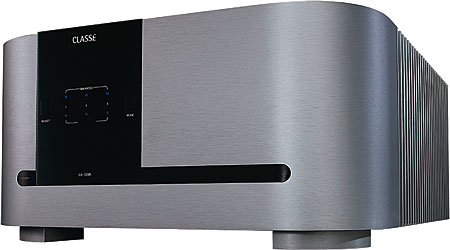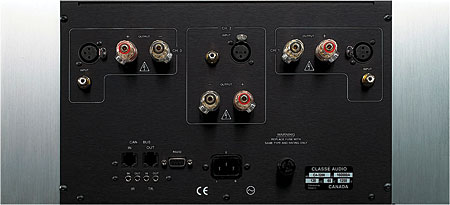| Columns Retired Columns & Blogs |
Classé CA-3200 three-channel power amplifier
The last Classé power amplifier I reviewed, back in November 2004, was the imposing Omega Omicron monoblock ($20,000/pair), which made glorious sound with the Revel Ultima Studio speakers. But things change. First, my reference speakers are now B&W 802Ds. Second, my system now has three front speakers, supplemented by two B&W 804S speakers for surround sound. While a quintet of Omicrons would undoubtedly be dandy, five such monoliths would take up so much space that I'd be wondering about their effects on the room's sound. With so many channels, it seemed time to investigate whether a multichannel amp could carry the load.

Classé's relatively new CA-series amps come with one (CA-M400), two (CA-2100, CA-2200), three (CA-3200), and five (CA-5200) channels, the first digit of each model number indicating the number of channels, the last three the rated power per channel. I opted for the CA-3200 ($6000) to drive my three B&W 802Ds to ensure consistent voicing across the front of the soundstage.
Description and setup
The CA-3200 arrived in a corrugated plastic box. Inside, stiff foam inserts closely embraced all surfaces of the amp, and even interdigitated with the heatsinks. When I removed the top and the foam, the box walls fell away to reveal a beautifully shaped piece of audio art. Anodized in satin silver, the CA-3200's gently curved front panel has a large black square within which are the Classé logo, setup buttons, and indicator LEDs. The bottom edge of the square is contiguous with a long black bar, along which are found the On/Standby switch and the model name. This is all effectively reminiscent of Classé's current disc players, whose control panels and disc drawers are here suggested by and transformed into pure visual design.
The CA-3200's rear has an outlined area for each channel. Each area contains the requisite RCA jack, XLR receptacle, and pair of multiway binding posts. (Also evident are where Classé would neatly fit in two more areas for the five-channel CA-5200.) From left to right across the bottom are CANBus, IR, and DC control ports, an RS-232 connector, a central EIA AC power receptacle, and an AC mains fuse post. Heatsink fins cover more than half of each side of the chassis.
Setting up the CA-3200 went as smoothly and satisfyingly as unpacking it had: Connect the amp to AC, but leave it in Standby to set up the inputs. Address each channel with the Select button. Choose RCA or XLR input with the Mode button. (Unlike the Omega Omicron and many other amps, the CA-3200 has no jumper for the XLR inputs when instead you use the RCAs, which means there's no jumper to misplace.) Blue LEDs indicate the input mode of each channel and also serve as fault indicators: one blinking red LED suggests a fault related to that channel, and three blinking red LEDs suggest a systemic problem. I'll have to take Classé's word that the C-3200 even has red LEDs—nothing I did made them blink.
I inserted AudioQuest Cheetah/DBS balanced interconnects in the CA-3200's XLR inputs, and ran AQ's Mont Blanc/DBS biwire speaker cables to the B&W 802Ds. I then hit the CA-3200's Standby button, which promptly went dark. The three channels then awoke one by one, as indicated by their blue LEDs.
Sound
From the first instant, the CA-3200 impressed me with its clarity and openness through the B&W 802Ds, along with something that sounded faintly familiar: Was this the same sound as the Omega Omicrons? I never heard the Omicrons through the 802Ds, or listened to the two amps side by side, so I can't say with certainty—but I could probably repeat most of my comments on the Omicron here as being descriptive of the CA-3200 as well.
The CA-3200 seemed to neither favor nor slight any particular portion of the audible spectrum. The bass was sufficiently generous and well-defined that tonal distinctions among different timpani were clear, even in recordings with lots of hall ambience. Similarly, I could play powerful organ-pedal notes at high levels without any change of balance between fundamental and overtones. Sound effects, such as thunder or a carelessly dropped microphone stand, were startlingly palpable.
Climbing from the sonic basement to those floors where human voices live was equally satisfying. All manner of voices were delivered with consistency and, more often than not, that peculiar human quality that grabs one's attention. A marvelous SACD of orchestral songs by Sibelius, with soprano Soile Isokoski and Leif Segerstam conducting the Helsinki Philharmonic Orchestra, has just been released (Ondine ODE 1080-5). (I bought this disc for Luonnotar, but the whole program is simply gorgeous.) Whether I played it in stereo through two B&W 802Ds or two Pioneer S-1EXs—or, even better, in multichannel through three 802Ds—Isokoski's warm, round voice was richly present, and seemed to come right from the center 802D—even when I was playing only the two Pioneers! Sure, the orchestra was big and spread from side to side, but her voice was planted in my room in front of the ensemble, making it oh, so easy to suspend disbelief.
Throughout and above the midrange, the CA-3200 was sweet and extended. Though definitely not bright, the high frequencies were just on the non-zingy side of neutral—a characteristic, I believe, of a good modern amp that does not need to compensate for limited-bandwidth speakers or sources. Tapped or brushed cymbals had a distinctly metallic quality but were properly placed in the soundscape. The now-famous maracas in "Yulunga," from Dead Can Dance's Into the Labyrinth (CD, 4AD 3013-2), were right inside the front-channel B&Ws' Marlan HF/mid heads, not in front, where overbright equipment can place it. And the bass on this track was fabulous.
The consummate test was the National Polish Radio Symphony's recording of Krzysztof Penderecki's Credo, with the composer conducting, which I featured in last November's "Recordings in the Round" (SACD, Polskie Radio PR SACD 1). The huge and varied forces employed here can tax any system with their complexity, dynamic range, and—more significant—the ambience of the high, deep church in which it was recorded. I played this SACD with, again, the CA-3200 driving two (stereo DSD track) as well as three B&W 802Ds, the latter in both 5.0- and 5.1-channel arrangements. While the latter was the most satisfying, emotionally and aesthetically, the two-channel performance lacked only the ability to specifically localize the direct sounds in the rear of the church's enveloping acoustic. The vocal soloists and orchestra were similarly reproduced across the front of the stage regardless of how many speakers were playing. At some of the highest volume levels I can normally accommodate (intermittently, >100dB), there was no smudging of details or any loss of precision.

Whether or not I relieved the CA-3200 of the extreme-low-frequency burden by sending the ".1" LFE channel to my JL Audio Fathom f113 powered subwoofer made little difference. With the sub, my feet now felt the organ-pedal notes, but the overall balance and clarity were unchanged. Sure, the CA-3200's 200Wpc is somewhat less than the Omega Omicron monoblock's 300W, the Simaudio Evolution W-8's 250Wpc ($10,200, reviewed in March 2006), or the Bel Canto e.One REF1000 monoblock's 500W ($1995 each, "Music in the Round," November 2006)—but it was more than adequate for the supposedly power-hungry B&Ws. The Classé coasted with the Pioneers, despite the S-1EX's nominally lower sensitivity.
Comparisons
Comparing the CA-3200 with the other amps on hand, I heard only small differences that, considering their pedigrees, were not surprising. Since so much depends on the speakers and the room, I couldn't point my finger at any one of these amps and say that it, alone, was "neutral." The Simaudio Moon Evolution W-8 and the Classé CA-3200 were nearly indistinguishable, especially in the midrange, so I was forced to the extremes to distinguish them. The CA-3200 seemed to lack the W-8's incredible grip and power in the bass, something only Classé's bigger Omega amps could probably manage. More significant was a subtle impression that the W-8 was warmer and more velvety in the top end, the CA-3200 more open and transparent. By contrast, the Bel Canto e.One REF1000 monoblocks were both less warm than the W-8 and less open than the CA-3200, but more closely approached the W-8's bass performance. Tellingly, all of my impressions of differences in the amps' HF performance were fleeting and insubstantial when I rapidly A/B'd them in mono, but they returned with stereo listening, while the amps' differences in bass performance remained apparent throughout. Though I think the two test conditions revealed different things about these amps, it's their stereo and multichannel performance that we care about, so I find it difficult to discount those subtle differences.
In terms of speaker matching, the CA-3200 was a nigh on perfect partner to the B&W 802D—not surprising, considering the products' familial connections [both companies are owned by Equity International—Ed.]. The W-8 was a bit softer at the upper end, requiring some compensatory re-aiming of the B&Ws to put me directly on the tweeter axes and restore "presence" to the upper midrange and lower treble. My (so far) brief experience of the Pioneer S-1EX suggests that the Bel Canto e.One REF1000s may nose out the CA-3200 with those speakers. Listening to them, the best positioning for bass response resulted in the CA-3200 pulling the midrange a bit more forward than I prefer, but that was only a preliminary result. Bottom line: None of these combinations of amp and speaker was less than excellent, and anyone's preferences, including my own, might well be different in a different room.
Conclusions
The Classé CA-3200 is an impressive hunk of amplifier. On paper, it has less power and slightly more distortion than its much pricier big brother, the Omega Omicron, but it concedes little in performance. Judging it by the highest standards and with some of the best loudspeakers available, I can't fault the CA-3200's transparency, balance, or dynamics. As a mate to the B&W 802Ds, it was ideal. Combine that with seemingly bulletproof construction, and I find it impossible to suggest a better three-channel power amplifier. It's also available in two- and five-channel versions that should be equally outstanding.
- Log in or register to post comments




































